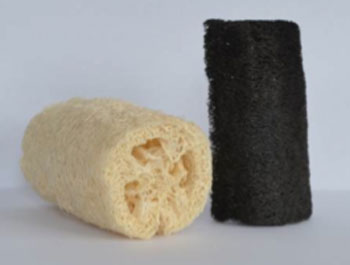| Posted: Dec 17, 2013 | |
Loofah sponges as 'green' anode material for microbial fuel cells |
|
| (Nanowerk Spotlight) There are many competing types of fuel cells, depending on what kind of fuel and oxidant they use. Many combinations of fuel and oxidant are possible. For instance, a hydrogen fuel cell uses hydrogen as fuel and oxygen as oxidant. In microbial fuel cells (MFCs), the naturally occurring decomposing pathways of electrogenic bacteria are used to both clean water and produce electricity by oxidizing biological compounds from wastewater and other liquid wastes. The catalytic activity of electroactive bacteria directly converts chemical energy into electrical energy. | |
| In MFCs, the anode material as the medium of electron transfer and as the support for biofilm formation is a key component that determines the effectiveness and efficiency of power generation. Generally, the anode will perform better if the anode material has a greater specific surface area and higher affinity for living bacterial cells. | |
| Addressing this challenge, researchers have been developing new anode materials. However, the problems associated with these anodes include small pore sizes; low biocompatibility and high biodegradability of the synthetic sponges; high costs due to the nanomaterials used; and complex procedures that include specific machinery for fabrication. | |
| The direct carbonization of low-cost and naturally available materials provides a potential alternative to commercial anodes with high specific surface area (see for instance: "Fuel cells from gelatin"). However, the pore sizes of the anodes from most of these natural materials are in the range of microns, thus, microbial clogging remains a concern for long-term applications in the MFCs. In this regard, researchers are trying to seek a natural material with macroporous structure and develop a simple method to decorate the natural material in order to obtain a nanostructured surface as well. | |
| In new work, scientists in China have demonstrated a new procedure to generate novel three-dimensional (3D) macroporous carbon prepared from a sponge-like natural product, namely, a fibrous loofah sponge. Loofah sponges are derived from the ripened fruit of loofah plants and are available at very low costs. These sponges are widely used for bath or kitchen cleaning due to their soft texture and high water uptake. | |
 |
|
| Photographic images of the loofah sponge (white) and the loofah sponge derived carbon (black). (Image: Dr. Shungui Zho, Guangdong Institute of Eco-environmental and Soil Sciences) | |
| Reporting their work in a recent online edition of Environmental Science & Technology ("Nanostructured Macroporous Bioanode Based on Polyaniline-Modified Natural Loofah Sponge for High-Performance Microbial Fuel Cells"), the team showed that the preparation of a 3D electrode from this natural precursor provided a low-cost and sustainable method of fabricating MFC anodes. | |
| "A loofah sponge possesses a continuous 3D macroporous surface, which can offer a great specific surface area for the attachment of bacterial cells," Shungui Zhou, a professor at the Guangdong Institute of Eco-environmental and Soil Sciences, tells Nanowerk. "Furthermore, when we put nitrogen-enriched carbon nanoparticles on loofahs and loaded them with bacteria with a facile method, the MFC performance can be further improved." | |
| The researchers fabricated their electrode material by cutting a dried loofah sponge into small pieces and carbonizing it in a high-temperature furnace at 900 °C. To create microscopic structures on this loofah sponge carbon, it was decorated with nitrogen-enriched carbon nanoparticles that were fabricated by cocarbonizing nanosize polyaniline (PANI)-hybridized loofah sponges. | |
| "The open 3D macrostructure facilitates biofilm growth, and the nitrogen-enriched, carbon nanoparticle coating promotes extracellular electron transfer between the bacteria and the electrode," explains Zhou. "Due to the synergistic effect, a highly active electrochemical biofilm anode was produced, and its current density and maximum power density exceeded those of conventional carbon-based electrodes." | |
| Microbial fuel cell technology is very promising, but its large-scale commercial application is currently limited by several factors such as small-scale power output, high cost, and a lack of suitable scaling-up techniques. To improve the power output of MFCs, high-performance anodes are required because the anode material as the medium of electron transfer and as the support for biofilm formation is a key component in determining power generation. On the other hand, the cost of the electrode materials must be reduced. Therefore, as Zhou points out, special attention should be paid to cheap electrode materials and low-cost cathodic catalysts. | |
 By
Michael
Berger
– Michael is author of three books by the Royal Society of Chemistry:
Nano-Society: Pushing the Boundaries of Technology,
Nanotechnology: The Future is Tiny, and
Nanoengineering: The Skills and Tools Making Technology Invisible
Copyright ©
Nanowerk LLC
By
Michael
Berger
– Michael is author of three books by the Royal Society of Chemistry:
Nano-Society: Pushing the Boundaries of Technology,
Nanotechnology: The Future is Tiny, and
Nanoengineering: The Skills and Tools Making Technology Invisible
Copyright ©
Nanowerk LLC
|
|
|
Become a Spotlight guest author! Join our large and growing group of guest contributors. Have you just published a scientific paper or have other exciting developments to share with the nanotechnology community? Here is how to publish on nanowerk.com. |
|
